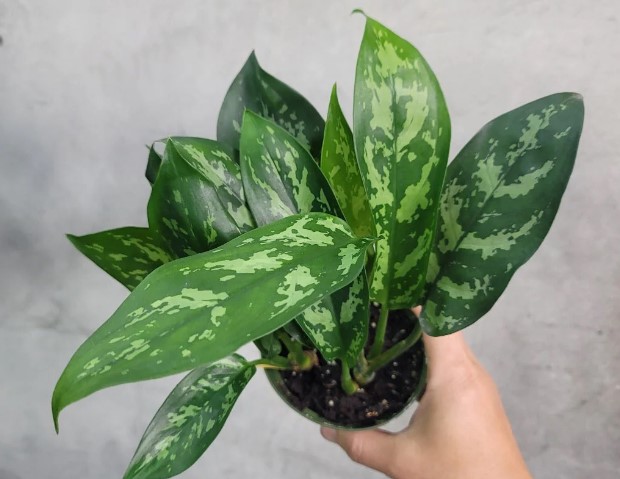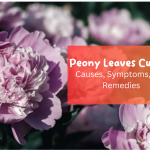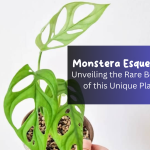Aglaonema Maria, also known as Chinese Evergreen or Aglaonema ‘Maria,’ is a stunning tropical plant renowned for its vibrant foliage and easy care requirements. With its captivating patterned leaves and adaptability to various indoor conditions, this houseplant has gained popularity among novice and experienced plant enthusiasts. In this comprehensive guide, we will explore the key features, care tips, and propagation methods for Aglaonema Maria, helping you create a thriving and visually appealing indoor garden.
Understanding Aglaonema Maria:
Aglaonema Maria is a cultivar of the Aglaonema genus, native to the tropical regions of Southeast Asia. Its most distinctive feature is its striking variegated leaves, which typically display shades of green and silver, complemented by intricate patterns and markings. The plant’s compact size and low-growing habit make it ideal for tabletops, shelves, or as a floor accent in your home or office.

Optimal Growing Conditions:
Aglaonema Maria thrives in moderate indoor conditions, making it suitable for various environments. Here are the key factors to consider for its growth:
- Lighting: While Aglaonema can tolerate low light conditions, it prefers medium to bright indirect light. Avoid exposing it to direct sunlight, as it may scorch the leaves. Placing it near a north or east-facing window is ideal.
- Temperature: This plant prefers temperatures between 65-80°F (18-27°C). Please protect it from drafts and sudden temperature fluctuations, adversely affecting its growth.
- Humidity: Aglaonema Maria appreciates higher humidity levels but can adapt to average household humidity. Misting the leaves or placing a tray of water nearby can help increase humidity levels.
- Soil and Potting: Use a well-draining potting mix rich in organic matter. A blend of peat moss, perlite, and compost is suitable. Ensure the pot has drainage holes to prevent waterlogging.
Watering and Fertilization:
Maintaining proper watering and fertilization practices is crucial for the health of your Aglaonema Maria:
- Watering: Allow the top inch of soil to dry out between waterings. Overwatering can lead to root rot, while underwatering can cause leaf yellowing. Adjust the watering frequency based on the season and environmental conditions.
- Fertilization: Feed your Aglaonema with a balanced liquid fertilizer monthly during the growing season (spring and summer). Dilute the fertilizer to half the recommended strength to avoid fertilizer burn. Reduce or stop fertilization during the winter months when growth slows down.
Pruning and Maintenance:
Regular pruning helps maintain the attractive shape and appearance of Aglaonema Maria:
- Remove yellow or brown leaves promptly to maintain plant health and aesthetics.
- Trim leggy stems to encourage bushier growth. Cut just above a node or leaf joint to promote new growth.
- Wipe the leaves occasionally with a damp cloth to remove dust and keep them looking vibrant.
Propagation:
Aglaonema Maria can be propagated through stem cuttings. Follow these steps for successful propagation:
- Select a healthy stem cutting with at least two or three leaves.
- Dip the cut end in a rooting hormone powder (optional) and plant it in a well-draining potting mix.
- Place the cutting in a warm, humid environment with indirect light. Mist the cutting occasionally to maintain humidity.
- Within a few weeks, the cutting will develop roots. You can then transplant it into a larger pot.

Conclusion:
Aglaonema Maria is a beautiful, low-maintenance houseplant that brings beauty and life to any indoor space. It’s stunning variegated foliage and adaptable nature make it an excellent choice for beginners and experienced plant lovers. By following the care guidelines outlined in this comprehensive guide, you can ensure the optimal growth and longevity of your Aglaonema, transforming your living or working space into a green oasis. Read article about Tradescantia Nanouk Brown Spots and Are Mango Trees Evergreen? in Avi Hoffman Garden.
FAQ
Aglaonema Maria offers several benefits as a houseplant. It adds a touch of natural beauty to indoor spaces and purifies the air by filtering out toxins. The plant’s lush foliage contributes to a calming and stress-relieving environment, making it an excellent choice for enhancing your home or office’s overall well-being and aesthetic appeal.
Aglaonema Silver Queen and Aglaonema Maria are two distinct cultivars of the Aglaonema genus. While both exhibit variegated foliage, they have notable differences:
Appearance: Aglaonema Silver Queen has broader, elongated leaves with silver-gray and green hues. In contrast, Aglaonema Maria showcases narrower leaves with a striking mix of green and silver patterns.
Growth Habit: Aglaonema Silver Queen tends to grow in an upright, more erect manner, while Aglaonema Maria has a compact, low-growing habit.
Light Tolerance: Aglaonema Silver Queen can tolerate lower light conditions better than Aglaonema Maria, which prefers medium to bright indirect light.
Ultimately, the choice between the two varieties depends on personal preference and the specific lighting conditions in your indoor space.
No, Aglaonema is not a prayer plant. The prayer plant belongs to the Maranta family (Marantaceae) and is scientifically known as Maranta leuconeura. Prayer plants, like Maranta leuconeura, are recognized for their unique leaf movements, which fold up or “pray” in the evening. Aglaonema plants, including Aglaonema Maria, do not possess this characteristic leaf movement. They belong to the Araceae family and are known for their attractive foliage patterns and air-purifying qualities.







